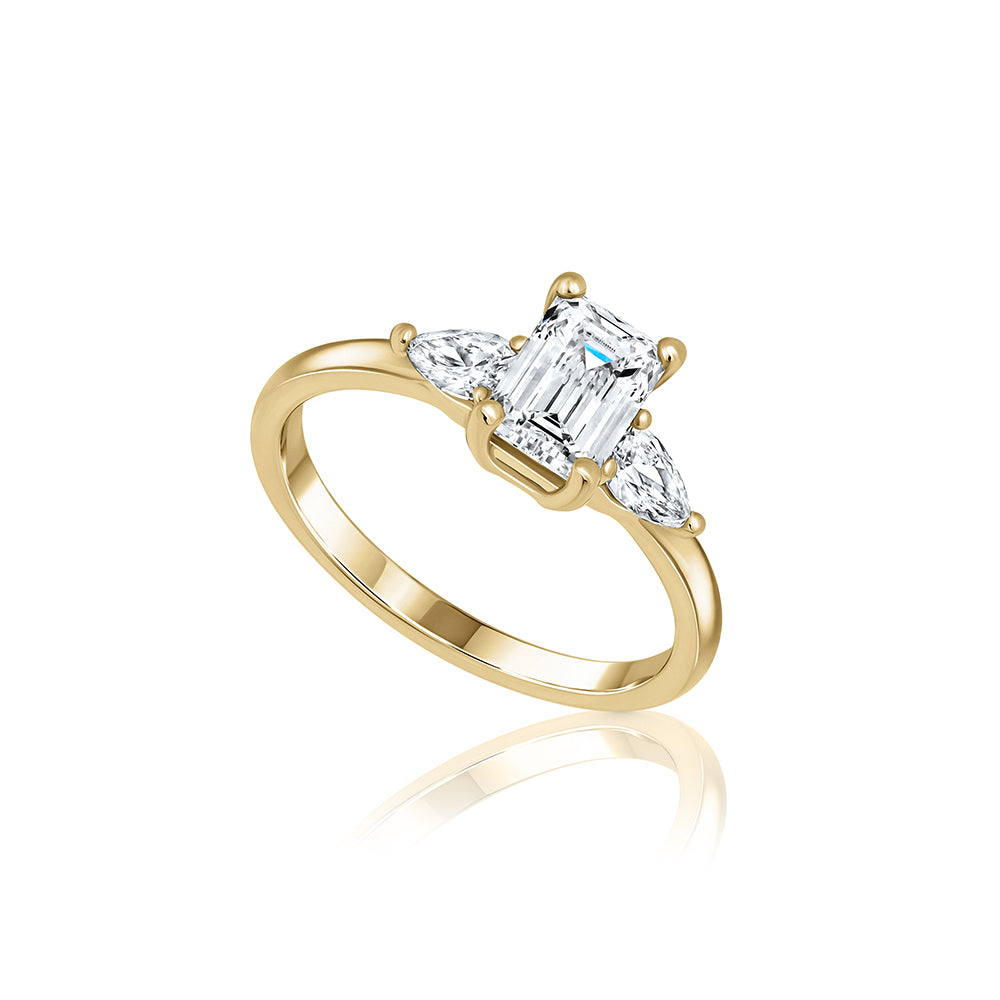Everything you need to know about lab-grown diamonds
What are lab-grown diamonds?
Lab-grown diamonds are engineered, man-made diamonds grown in a laboratory using an advanced technological process to mimic the conditions in which diamonds develop naturally over millions of years beneath the Earth's crust.
Over the past few years, the jewelry industry has begun selling lab-grown diamonds as a sustainable and ethical alternative to natural diamonds mined from the earth.
You may have heard of a lab-grown diamond engagement ring, or lab-grown diamond stud earrings, but you may not be clear about what exactly they are! Compared to diamonds from nature, the process of growing lab-grown diamonds takes only a few weeks. The lab uses carbon atoms arranged in the crystalline structure that characterizes natural diamonds, and these are grown under conditions that allow them to develop into raw diamonds.
Want to find out more about the production of lab-grown diamonds and what makes them unique? Keep reading!
How are lab-grown diamonds made?
Lab-grown diamonds are created from tiny carbon seeds harvested from existing natural diamonds. The advanced technology allows scientists to use two different techniques to replicate the way natural diamonds are formed in the earth: extreme pressure and heat conditions or a chemical vapor deposition process.
After six to ten weeks of growth, a raw diamond is created that can be cut, polished, and set in various gold jewelry , such as:
- Gold bracelets with lab-grown diamonds
- Lab-Ground Diamond Solitaire Earrings
- Or gold necklaces with pendants set with lab-grown diamonds
There are two main methods for growing lab-grown diamonds , from which you can design, for example, gold and lab-grown diamond bracelets:
- High Pressure High Temperature – HPHT (High Pressure High Temperature) – This method mimics the conditions under which diamonds are formed in nature, deep within the Earth. This technique uses a large machine that is fed a certain amount of carbon seeds derived from natural diamonds. The machine crushes the carbon material and applies high pressure and extreme temperatures ranging from 1600-1300 degrees Celsius.
- Chemical Vapor Deposition (CVD) – In this method, the carbon seeds of a natural diamond are placed in a small vacuum chamber filled with heated hydrogen and carbon-containing gases. At a certain temperature, the gas molecules begin to break down and layers of carbon begin to form around the carbon seed, a process that causes the diamond to grow and enlarge. Sometimes, lab-grown diamonds created by CVD are also pressure and heat treated after they have grown.

Lab-grown diamond vs. real diamond
The big difference between the two types of diamonds, a real diamond from nature and a lab-grown diamond, lies in their origin, with the natural diamond being formed deep beneath the Earth's mantle while the lab-grown diamond, as its name suggests, is grown in a laboratory.
Both natural and lab-grown diamonds have the same physical, chemical, and optical properties, and exhibit the same sparkle and luster. However, the appearance of lab-grown diamonds may exhibit trace elements, also called microminerals, while the appearance of natural diamonds is unaffected by them.
To the naked eye, you can't tell the difference between lab-grown diamonds and natural diamonds mined from the ground. They just look the same. So, to tell the difference between the two types of diamonds, scientists use special equipment.
Lab-grown diamonds vs. zirconia and moissanite
Zirconia or Moissanite are two gemstones considered to be the most common simulated diamonds in the jewelry world. That is, these gemstones are diamond-like, which look like diamonds but are not diamonds at all.
Lab-grown diamonds are completely different from diamond-like stones, such as zirconia and moissanite. And unlike lab-grown diamonds, which are made from carbon just like diamonds mined from the earth, diamond-like stones are not made from real carbon crystals.
Moissanite stones – These stones are found naturally in nature and do not originate from Earth but from outer space, from meteorites that landed on Earth. This is a mineral composed of silicon carbide , often called the ‘gemstone from the stars’. Moissanite stones were discovered inside a meteorite by Nobel Prize-winning chemist Henri Moissan in 1893, in Diablo Canyon in Arizona. This natural mineral, now called moissanite, was named after the same chemist, Moissan, who found it and later identified that these were not diamonds but silicon carbide.
Moissanite stones in their natural form are very rare, but there are jewelry pieces that feature lab-created moissanite stones. And while these are diamond-like stones, they often emit a more colorful sparkle than the bright sparkle of a traditional diamond.
Zirconia ( CZ ) – Zirconia is classified as a diamond simulant and is another example of a synthetic diamond-like crystal. Zirconia looks similar to diamond but is made from a different material. Unlike natural and lab-grown diamonds, which are made from carbon, zirconia is made from zirconium dioxide (ZrO2). Zirconia is durable and sparkly, but it lacks the luster of diamonds and will take on a somewhat worn appearance over time. In the world of jewelry design, zirconia is sometimes used as a temporary filler until it is replaced with a stronger gemstone.
- Diamond-like gemstones, such as zirconia and moissanite, can be distinguished from natural or lab-grown diamonds, even with the naked eye.
- The chemical and physical properties of natural diamonds and lab-grown diamonds are not the same as zirconia and moissanite, and their market price is much lower than the prices of diamonds.
- Because natural and lab-grown diamonds have thermal conductivity properties that zirconia does not, a hand-held tester can be used to check the identity of these gemstones.
- There is a similarity in the electrical conductivity of moissanite and some lab-grown diamonds and some naturally colored diamonds. Because of this similarity, some testers mistakenly identify moissanite as diamond.
- Gemologists often distinguish between diamonds and moissanite by examining the gemstone's refractive properties, with moissanites having double refraction and diamonds having single refraction.
A special classic gold necklace with a 1 carat emerald cut lab-grown diamond in a special enamel setting.

The advantages and disadvantages of lab-grown diamonds
The benefits of lab-grown diamonds
Lab-grown diamonds are a great alternative to diamonds mined from the ground. Here are some of the key benefits of lab-grown diamond jewelry, such as delicate gold rings or lab-grown diamond engagement rings :
- Ecological growth source.
- A source of ethical growth that is not rooted in the conflicts that create so-called 'blood diamonds.'
- Fewer imperfections on the surface of the diamond.
- The price is more affordable.
- Lab-grown diamonds can be produced in a variety of colors that are rarely found in nature, making them unique and desirable items that are also available in the local jewelry market.
- You can track the sources from which lab-grown diamonds come, ensuring that these gems do not come from places that violate the rights of workers or communities.
- Growing diamonds using the HPHT or CVD methods makes it easier for jewelers and designers to meet the high demand, without having to compromise on quality or engage in unethical business practices.
The disadvantages of lab-grown diamonds
- The value of lab-grown diamonds may decline in the long run. After all, unlike lab-grown diamonds that continue to be readily available, natural diamonds are rare and finite, so their prices tend to increase over time.
- A natural diamond comes with sentimental value and romantic appeal, feelings that are difficult to replicate in lab-grown diamonds.
A special gold chain earring studded with lab-grown baguette and round cut diamonds.

Frequently Asked Questions
What is a lab-grown diamond?
Lab-grown diamonds are diamonds that are grown in a controlled environment that uses technological procedures that replicate the natural conditions in which diamonds develop in nature.
Is it worth buying a lab-grown diamond?
Lab-grown diamonds have the same physical, chemical, and optical properties as diamonds mined from the earth, so they will remain durable over time and you can purchase them at a cheaper price.
Besides, lab-grown diamonds are considered an ethical and responsible choice, both from an environmental perspective and in terms of their non-involvement in the conflicts that create so-called 'blood diamonds.'
What is the difference between a lab-grown diamond and a natural diamond?
It is difficult to tell lab-grown diamonds from natural diamonds with the naked eye. So how do you identify a lab-grown diamond? Well, scientists can tell the difference by analyzing identifying markers formed on the diamond's surface due to its specific growth conditions.
How are lab-grown diamonds made?
Lab-grown diamonds use tiny carbon seeds from existing diamonds. Using advanced technology, scientists can mimic the process by which diamonds are formed in nature and replicate their growth in a lab. In effect, these tiny carbon seeds are used to create a raw diamond that is then cut and polished so that it can be set in a variety of luxury jewelry, such as:
- Ring with lab-grown diamond
- Bracelet with lab-grown diamond
Do lab-grown diamonds have value?
Lab-grown diamond jewelry radiates the same beauty, transparency, and sparkle as a natural diamond, but at a much lower price. This way, you can enjoy lab-grown diamonds that share the same physical, chemical, and aesthetic properties as diamonds from nature, available as lab-grown diamond earrings , lab-grown diamond pendants, or lab-grown diamond rings. However, because natural diamonds are rare and finite, their prices tend to increase over time, which is unlikely to happen to lab-grown diamonds.
Is it possible to distinguish between a lab-grown diamond and a real diamond?
A lab-grown diamond is grown from a seed of carbon taken from an existing diamond, so it looks exactly like a real diamond from nature, is just as shiny and sparkling as it is, and has the same properties. To tell the difference in appearance between these two types of diamonds, you need to use special equipment and analyze the markers that show whether the diamond is naturally grown or lab-grown.
How long will lab-grown diamonds last?
Lab-grown diamonds will last for many years, just like natural diamonds, and they will look exactly the same in a million years as they did the moment they were created in the lab.
Are there colored lab-grown diamonds?
When, during the growth stage of lab-grown diamonds, small amounts of specific trace elements (microminerals) are found in the material, the result will be colorful and magnificent lab-grown diamonds, just as they occur in nature. The price of lab-grown colored diamonds is cheaper than the prices of natural colored diamonds.
Does the color of a lab-grown diamond fade over time?
Lab-grown diamonds are available in a variety of clear or fancy colors that are rarely found in nature, including vibrant hues like bright yellow, blue, or pink. Because lab-grown diamonds share the same properties as naturally occurring diamonds, the color of a lab-grown diamond is unlikely to fade, just as colored diamonds mined from the earth never fade.






